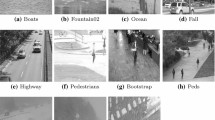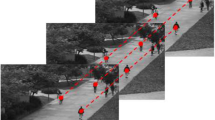Abstract
Background subtraction from compressive measurements (BSCM) is a fundamental and critical task in video surveillance. Existing methods have limitations for incorporating the structural information and exhibit degraded performance in dynamic background, shadow and complex natural scenes. To address this issue, we propose a new Tucker decomposition-based sparse tensor optimization problem, which makes full use of the spatio-temporal features embedded in the video. The ℓ0-norm in the objective function is used to constrain the sparseness of the spatio-temporal structure of video foreground, which enhances the spatio-temporal continuity and improves the accuracy of foreground detection. The orthogonality constraints on factor matrices in low-rank Tucker decomposition are used to characterize the spatio-temporal correlation of video background, which enhances low-rank characterization and makes better background estimation. Optimality analysis in terms of Karush-Kuhn-Tucker (KKT) conditions is addressed for the proposed sparse tensor optimization problem and a hard-threshing based alternating direction method of multipliers (HT-ADMM) is designed. Comprehensive experiments are conducted on real-world video datasets to demonstrate the effectiveness and superiority of our approach for BSCM.










Similar content being viewed by others
Notes
For each video, 128 gray-scale video frames are chosen as video volume for our experiments, which is the same as in [11].
References
Absil PA, Mahony R, Sepulchre R (2008) Optimization algorithms on matrix manifolds. Princeton University Press, Princeton
Abualigah L M (2019) Feature selection and enhanced krill herd algorithm for text document clustering. Springer Nature Switzerland AG, Berlin
Abualigah LM, Khader AT, Hanandeh ES (2018) Hybrid clustering analysis using improved krill herd algorithm. Appl Intell 48:4047–4071
Andrews S, Antoine V (2014) A comprehensive review of background subtraction algorithms evaluated with synthetic and real videos. Comput Vis Image Underst 122:4–21
Aur\(\acute {e}\)lio C, Mohamed K, Andrews S, Christopher GB, hadi Zahzah E (2014) Incremental and multi-feature tensor subspace learning applied for background modeling and subtraction. In: International conference image analysis and recognition, pp 94–103
Bouwmans T (2014) Traditional and recent approaches in background modeling for foreground detection: An overview. Comp Sci Rev 11-12:31–66
Boyd S, Lieven V (2004) Convex optimization. Cambridge University Press, Cambridge
Candès EJ, Benjamin R (2009) Exact matrix completion via convex optimization. Found Comput Math 9(6):717–772
Candès EJ, Justin R, Tao T (2006) Robust uncertainty principles: exact signal reconstruction from highly incomplete frequency information. IEEE Trans Inf Theory 52(2):489–509
Candès EJ, Tao T (2005) Decoding by linear programming. IEEE Trans Inf Theory 51(12):4203–4215
Cao W, Wang Y, Sun J, Meng D, Yang C, Cichocki A, Xu Z (2016) Total variation regularized tensor rpca for background subtraction from compressive measurements. IEEE Trans Image Process 25(9):4075–4090
Cevher V, Sankaranarayanan A, MarcoF D, Reddy D, Chellappa R (2008) Compressive sensing for background subtraction. In: 10th european conference on computer vision: Part II, pp 155–168
Chen L, Liu J, Wang X (2020) Background subtraction with kronecker-basis-representation based tensor sparsity and l1,1,2 norm. Multidim Syst Sign Process 5-6:1–14
Cichocki A, Zdunek R, Phan AH, Amari SI (2009) Nonnegative matrix and tensor factorizations: Applications to exploratory multi-way data analysis and blind source separation. Wiley Publishing, Hoboken
Coifman R, Geshwind F, Y M (2001) Noiselets. Appl Comput Harmon Anal 10(1):27–44
Deng W, Lai MJ, Peng Z, Yin W (2013) Parallel multi-block admm with o(1/k) convergence. J Sci Comput 71(2):712–736
Dharmpal T, JasonN L, MichaelB W, MarcoF DB, Shriram S, KevinF K, RichardG B (2006) A new compressive imaging camera architecture using optical-domain compression. Computational Imaging IV at SPIE Electronic Imaging 6065:43–52
Foucart S (2011) Hard thresholding pursuit: An algorithm for compressive sensing. SIAM J Numer Anal 49(6):2543–2563
Gao Z, Cheong L-F, Wang Y (2014) Block-sparse RPCA for salient motion detection. IEEE Transactions on Pattern Analysis and Machine Intelligence 36(10):1975–1987
Hu W, Yang Y, Zhang W, Xie Y (2017) Moving object detection using tensor-based low-rank and saliently fused-sparse decomposition. IEEE Transactions On Image Processing 26(2):724–737
Javed S, Mahmood A, Bouwmans T, Jung SK (2017) Background-foreground modeling based on spatiotemporal sparse subspace clustering. IEEE Transactions on Image Processing A Publication of the IEEE Signal Processing Society 26(12):5840–5854
Jiang H, Deng W, Shen Z (2012) Surveillance video processing using compressive sensing. Inverse Probl Imag 6(2):201–204
Jiang H, Zhao S, Shen Z, Deng W, Wilford A P, Haimi-Cohen R (2014) Surveillance video analysis using compressive sensing with low latency. Bell Labs Technical Journal 18(4):63–74
Kolda TG, Bader BW (2007) Efficient MATLAB computations with sparse and factored tensors. SIAM Journal on Scientific Computing 30:205–231
Kolda TG, Bader BW (2009) Tensor decompositions and applications. SIAM Rev 51(3):455–500
Lathauwer LD, Moor BD, Vandewalle J (2000) On the best rank-1 and rank-(r1,r2,...,rn) approximation of higher-order tensors. SIAM Journal On Matrix Analysis and Applications 21:1324–1342
Li L, Huang W, Gu YHI, Tian Q (2004) Statistical modeling of complex backgrounds for foreground object detection. IEEE Trans Image Process 13(11):1459–1472
Lu C, Feng J, Chen Y, Liu W, Lin Z, Yan S (2020) Tensor robust principal component analysis with a new tensor nuclear norm. IEEE Transactions on Pattern Analysis and Machine Intelligence 42(4):925–938
Lu Z (2015) Optimization over sparse symmetric sets via a nonmonotone projected gradient method. arXiv:1509.08581
Luo Z, Yu X, Li X (2019) An ℓ0-norm minimization for energy-efficient timetabling in subway systems. IEEE Access 7:59422–59436
Nil G, Pierre-Marc J, Porikli F (2012) Changedetection.net: A new change detection benchmark dataset. In: 2012 IEEE computer society conference on computer vision and pattern recognition workshops, pp 1–8
Piccardi M (2005) Background subtraction techniques: a review. In: IEEE international conference on systems IEEE, pp 3099–3104
Qin ZT, Goldfarb D (2014) Robust low-rank tensor recovery: models and algorithms. SIAM Journal on Matrix Analysis and Applications 35 (1):225–253
Rockafellar TR, Wets JB (1998) Variational analysis. Sobolev and BV Spaces, MPS-SIAM Series on Optimization 30:324–326
Shakeri M, Zhang H (2019) Moving object detection under discontinuous change in illumination using tensor low-rank and invariant sparse decomposition. arXiv:1904.03175
Sobral A, Javed S, Jung SK, Bouwmans T, Zahzah EH (2015) Online stochastic tensor decomposition for background subtraction in multispectral video sequences. In: IEEE International conference on computer vision (ICCV), Workshop on robust subspace learning and computer vision (RSL-CV), pp 946–953
Tang Y, Meng D, Han Z, Chen X, Liang D, Luo Q, Wang Y (2017) Tensor rpca by bayesian cp factorization with complex noise. In: IEEE International conference on computer vision, pp 5029–5038
The EC Funded CAVIAR project/IST 2001 37540, found at http://homepages.inf.ed.ac.uk/rbf/CAVIAR/
Thierry B, El HZ (2014) Robust pca via principal component pursuit: A review for a comparative evaluation in video surveillance. Comput Vis Image Underst 122:22–34
Wakin MB, Laska MF, Dror B, Shriram S, Dharmpar T, Kelly KF, Baraniuk RG (2006) An architecture for compressive imaging. In: Image processing, 2006 IEEE International conference, pp 1273–1276
Wang Y, Yin W, Zeng J (2019) Global convergence of ADMM in nonconvex nonsmooth optimization. J Sci Comput 78(1):29–63
Wang Z, Bovik AC, Sheikh HR, Simoncelli EP (2014) Image quality assessment: From error visibility to structural similarity. IEEE Trans Image Process 13(4):600–612
Waters AE, AswinC S, RichadG B (2011) SpaRCS: Recovering low-rank and sparse matrices from compressive measurements. In: Neural information processing systems (NIPS), pp 1089–1097
Wright SJ, Nowak RD (2008) Sparse reconstruction by separable approximation. In: IEEE International conference on acoustics, speech and signal processing, vol 57, pp 2479–2493
Zhang T, Liu S, Xu C, Lu H (2013) Mining semantic context information for intelligent video surveillance of traffic scenes. IEEE Transactions on Industrial Informatics 9(1):149–160
Zhang T, Liu S, Ahuja N, Yang MH, Ghanem B, Si L (2015) Robust visual tracking via consistent low-rank sparse learning. Int J Comput Vis 111(2):171–190
Zhao Q, Meng D, Xu Z, Zou W, Zhang L (2014) Robust principal component analysis with complex noise. In: International conference on machine learning, pp 55–63
Zhou S, Xiu N, Qi H (2019) Global and quadratic convergence of newton hard-thresholding pursuit. arXiv:1901.02763
Acknowledgments
This work is supported by the Fundamental Research Funds for the Central Universities of China (2019JBM078).
Author information
Authors and Affiliations
Corresponding author
Additional information
Publisher’s note
Springer Nature remains neutral with regard to jurisdictional claims in published maps and institutional affiliations.
Rights and permissions
About this article
Cite this article
Yu, X., Luo, Z. A sparse tensor optimization approach for background subtraction from compressive measurements. Multimed Tools Appl 80, 26657–26682 (2021). https://doi.org/10.1007/s11042-020-10233-9
Received:
Revised:
Accepted:
Published:
Issue Date:
DOI: https://doi.org/10.1007/s11042-020-10233-9




